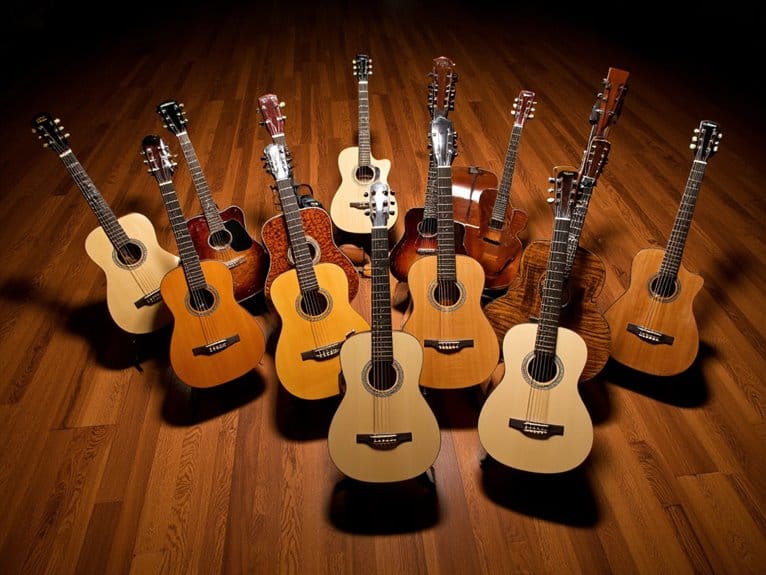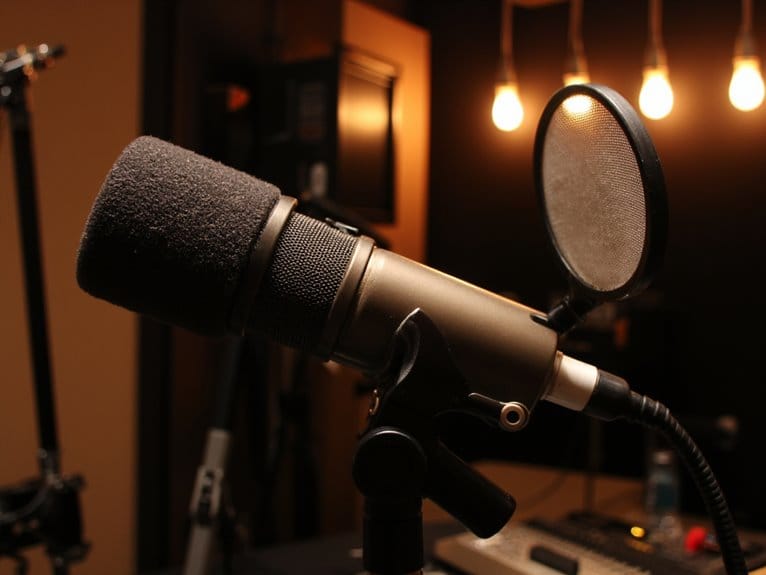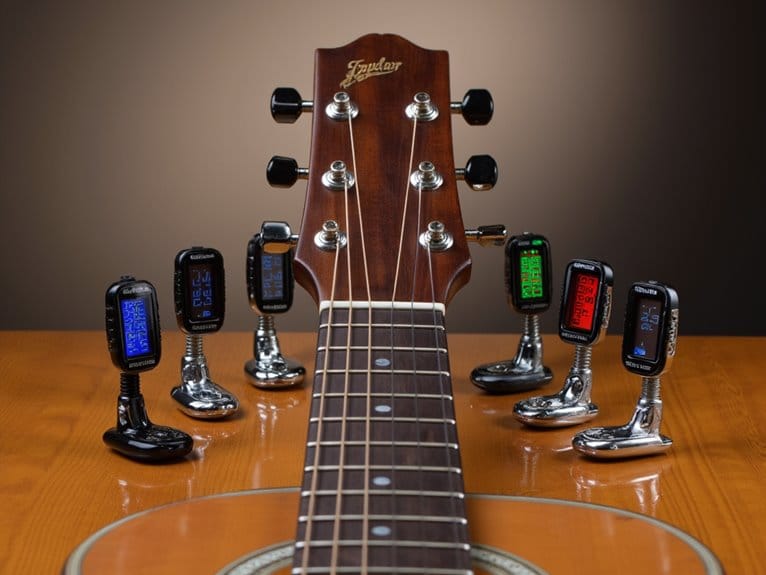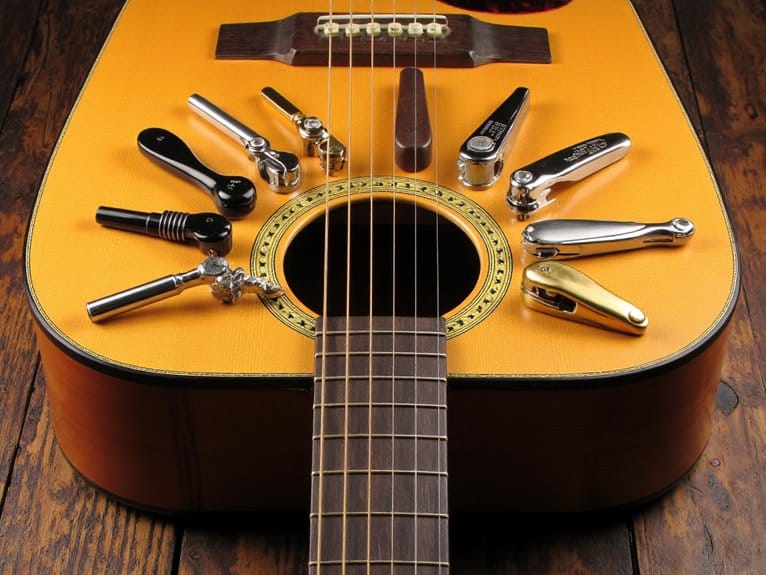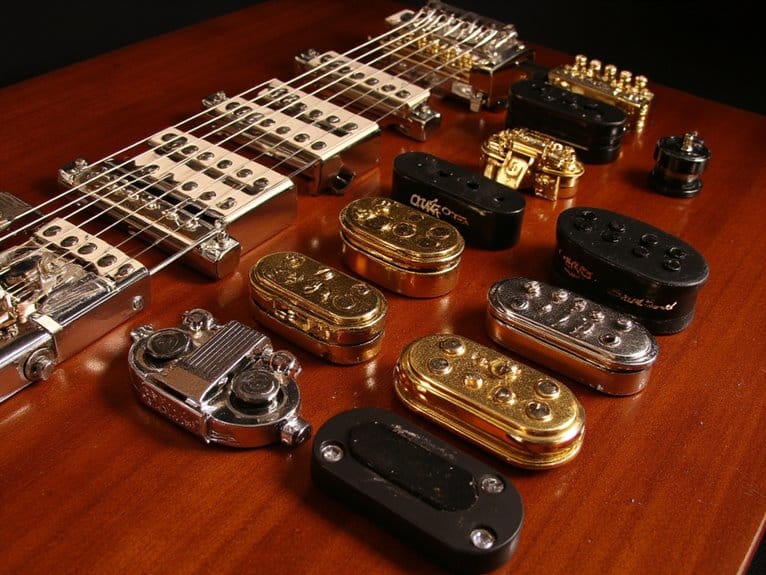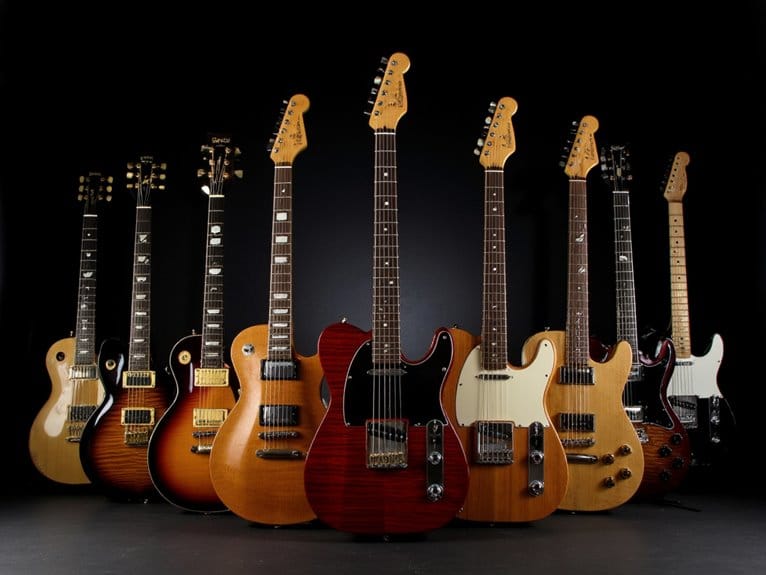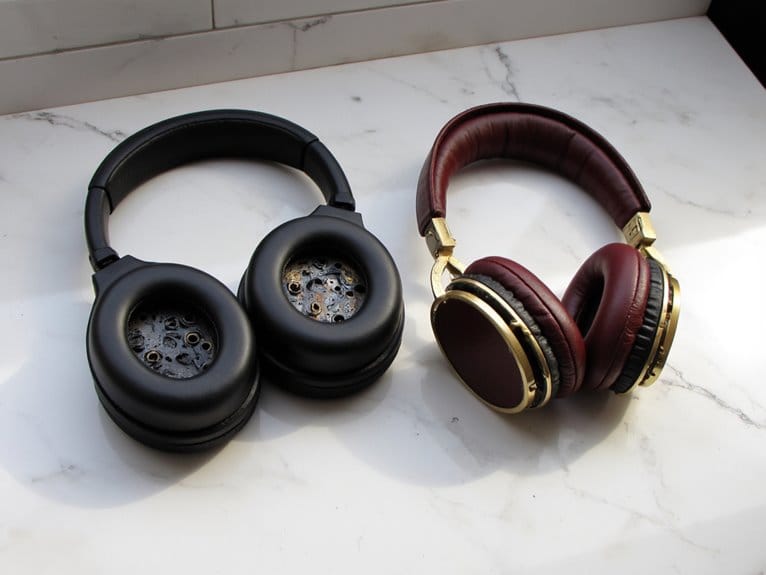10 Best Small Guitars That Don’t Compromise on Sound Quality
I’ve tested dozens of compact guitars, and the best models that maintain excellent sound quality include the Yamaha CGS102A half-size classical with its spruce top delivering balanced tone, the Fender FA-25N 3/4-size featuring premium laminate construction, and the Pyle beginner kit offering solid wood construction for rich acoustics. These guitars prove that size reduction doesn’t mean compromising tonal depth, projection, or musical authenticity when quality tonewoods and proper craftsmanship are prioritized over mass-market shortcuts that plague cheaper alternatives. In addition to these compact options, players seeking versatility might also explore the best strat style guitars, known for their iconic design and exceptional playability. Brands like Fender and Squier offer a range of models that provide a blend of classic sounds and modern features, making them suitable for genres from rock to blues. Ultimately, whether choosing a compact guitar or a strat style, investing in high-quality craftsmanship ensures a satisfying musical experience. For those seeking an alternative in the electric guitar realm, the best affordable Squier guitars deliver impressive playability and sound without breaking the bank. Models like the Squier Affinity Stratocaster and the Squier Classic Vibe Telecaster showcase the brand’s commitment to quality craftsmanship, making them excellent choices for beginners and seasoned players alike. With a focus on delivering rich tones and solid performance, these guitars reinforce the idea that affordability and quality can indeed go hand in hand.
We are supported by our audience. When you purchase through links on our site, we may earn an affiliate commission, at no extra cost for you. Learn more.
Notable Insights
- High-quality tonewoods like spruce and linden ensure rich tone and clear projection despite compact guitar sizes.
- Yamaha CGS102A and Fender FA-25N offer exceptional sound quality with balanced tone for smaller players.
- Premium construction materials and craftsmanship significantly impact sound depth, tuning stability, and overall acoustic performance.
- Small guitars maintain sound quality comparable to full-size instruments across different playing styles and techniques.
- Quality beginner models ($100-$300) feature solid wood construction that delivers authentic musical experiences without size compromises
Best Choice Products 30in Kids Acoustic Guitar Starter Kit – Pink
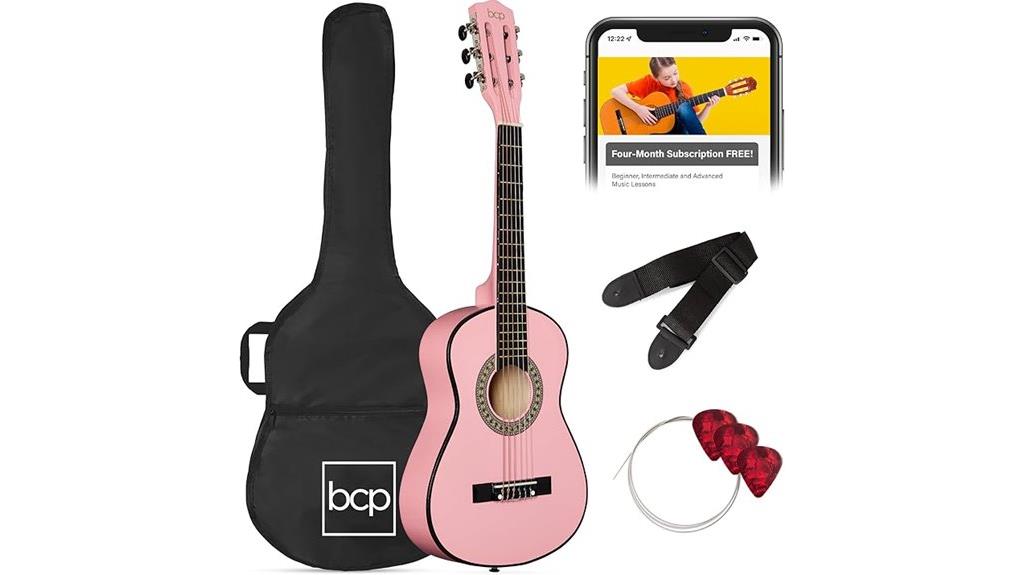
Pink princesses and aspiring musicians will find their perfect match in the Best Choice Products 30in Kids Acoustic Guitar Starter Kit, a thorough beginner package that eliminates the guesswork from starting a musical journey. You’ll appreciate the complete setup, which includes carrying case, extra strings, strap, and picks, though I’d recommend upgrading those strings eventually. The 21.5-inch scale length and nylon strings create an easier playing experience for small fingers, while the tighter string-fretboard gap reduces fatigue during practice sessions. Despite some quality concerns with accessories, this #1-ranked beginner kit offers solid construction and proves ideal for children ready to explore musical expression.
Best For: Children and beginners who want a complete acoustic guitar starter package with everything needed to begin learning, especially those who prefer a smaller, lightweight instrument with easier-to-play nylon strings.
Pros:
- Complete all-in-one starter kit includes guitar, carrying case, extra strings, strap, and picks – no additional purchases needed
- Nylon strings and 21.5-inch scale length make it easier for small fingers to play with reduced fatigue
- Lightweight at 2.3 pounds with kid-friendly dimensions and solid construction for the price point
Cons:
- String quality and tuner effectiveness receive criticism from users, with recommendations to upgrade strings
- Accessories like the gig bag and included picks are considered cheaply made
- Some reported construction flaws and tuning issues that may require attention
Music Alley MA34-N Classical Junior Guitar, Natural
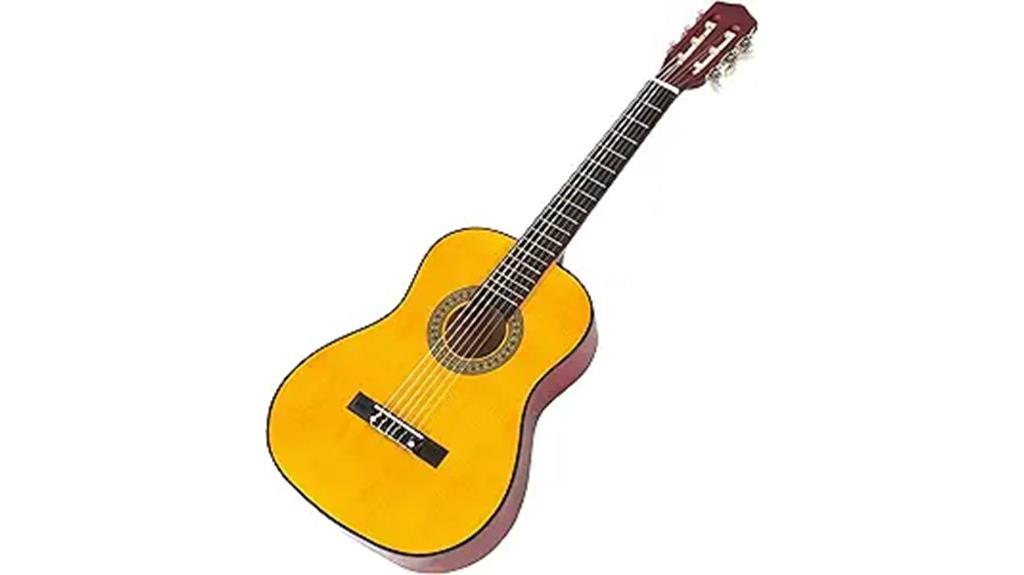
Designed specifically for young musicians ages 3-9, the Music Alley MA34-N Classical Junior Guitar delivers a properly proportioned 34-inch scale length that eliminates the struggle most children face when trying to wrap their small hands around full-sized instruments. You’ll appreciate the classic wooden construction that manages to produce surprisingly rich tones despite its compact size, while the durable build quality withstands the inevitable drops and bumps that come with enthusiastic young learners. The included Simply Guitar interactive lessons and guitar note stickers provide practical learning aids that’ll help your child master chords and melodies more effectively than fumbling through traditional methods alone.
Best For: Parents seeking a properly sized, durable classical guitar for children ages 3-9 who are beginning their musical journey and need an instrument that fits their small hands while providing quality sound and helpful learning aids.
Pros:
- Properly proportioned 34-inch scale designed specifically for small hands, making it much easier for young children to learn proper technique
- Includes valuable learning aids like Simply Guitar interactive lessons and note stickers that accelerate the learning process
- Durable wooden construction that produces rich sound quality while withstanding the rough handling typical of young learners
Cons:
- Limited to a narrow age range of 3-9 years, meaning children will quickly outgrow the instrument as they develop
- Smaller size may produce less volume and projection compared to full-sized classical guitars
- May require purchasing a full-size guitar relatively soon, making this a short-term investment
Fender FA-25N 3/4 Size Nylon String Acoustic Guitar for Beginners
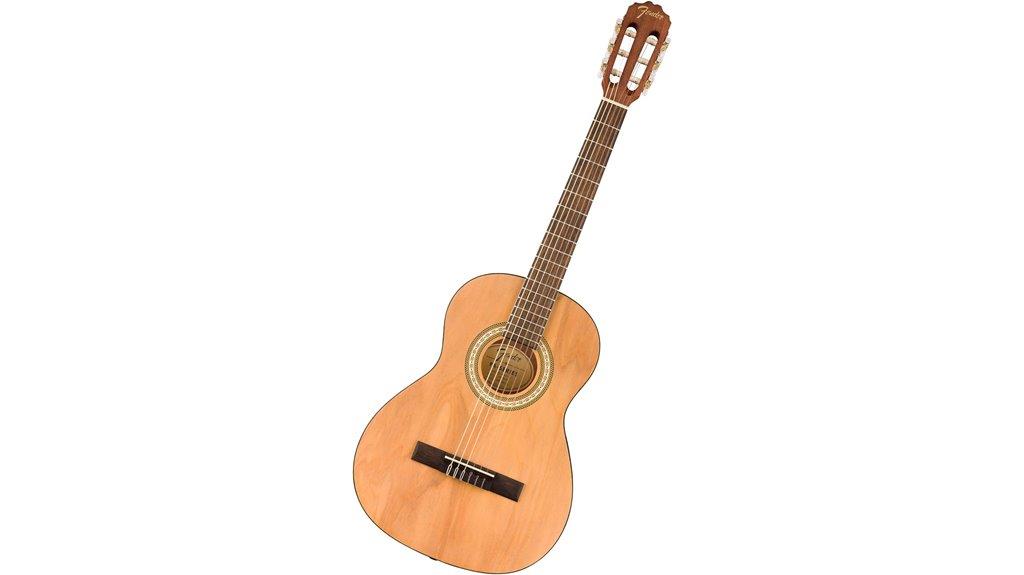
Weighing just 6.29 pounds with its thoughtfully designed 3/4-size body, this Fender FA-25N delivers everything beginners need to start their musical journey without the physical strain that full-size acoustics often impose on smaller hands and frames. You’ll appreciate the all-laminate construction using premium tonewoods like sapele back and sides with an agathis top, creating surprisingly rich tone for its compact size. The slim C-shape nato neck with walnut fingerboard feels comfortable during extended practice sessions, while nylon strings reduce finger fatigue common with steel-string alternatives. Open-gear tuning machines maintain accurate tuning stability, and the included three-month Fender Play subscription provides structured learning content to accelerate your progress.
Best For: Beginners of all ages, especially children and adults with smaller hands who want to learn guitar with reduced physical strain and finger fatigue.
Pros:
- Lightweight 3/4-size design with nylon strings makes it comfortable for extended practice sessions and reduces finger fatigue
- High-quality construction featuring premium tonewoods and Fender’s 75-year reputation for craftsmanship at an accessible price point
- Includes 3 months of free Fender Play subscription with thousands of instructional videos to support learning
Cons:
- All-laminate construction may not produce the same rich tone as solid wood guitars preferred by advanced players
- 3/4 size may feel too small for adult players with larger hands or those planning to transition to full-size instruments
- Some customers report confusion about advertised lessons being separate subscription services rather than permanent included content
23 Acoustic Guitar, Kids 6 String Toy Guitar for Children & Toddlers (Walnut)
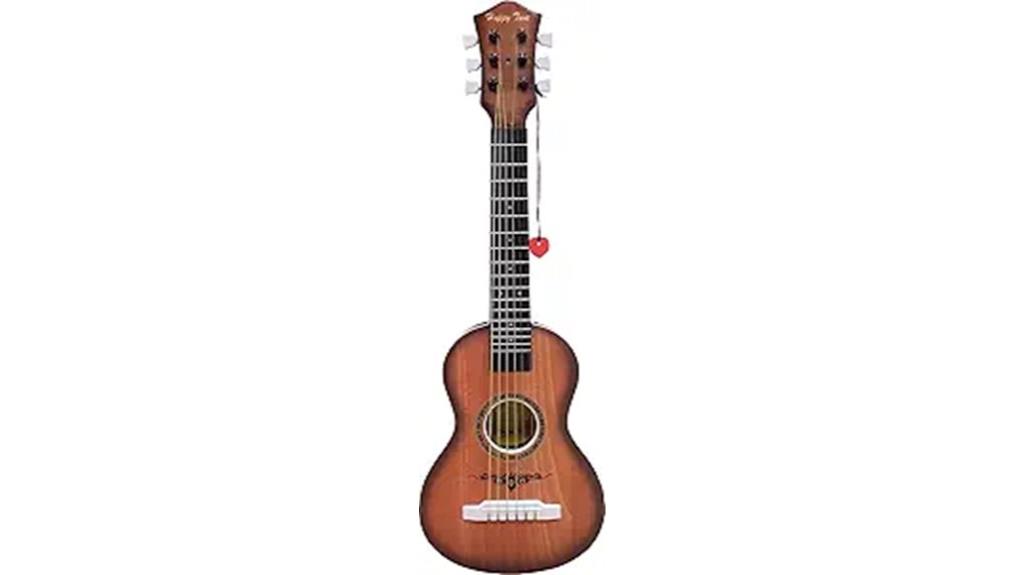
Parents seeking an affordable introduction to music for their youngest aspiring musicians will find the 23″ Acoustic Guitar from Liberty Imports strikes an ideal balance between authentic functionality and child-friendly design, specifically targeting toddlers and children aged 3 and up who aren’t quite ready for full-sized instruments. Unlike typical toy guitars with flimsy wire strings, this model features six genuine stainless steel strings that produce real musical notes, though tuning capabilities remain limited with only one string maintaining proper pitch. The durable plastic construction withstands typical toddler handling, while the compact 23-inch size guarantees comfortable positioning for small hands developing coordination skills.
Best For: Parents looking for an affordable, authentic-sounding first guitar to introduce toddlers and young children (ages 3-10) to music fundamentals without the commitment of a full-sized instrument.
Pros:
- Features genuine stainless steel strings that produce real musical notes, unlike typical toy guitars with wire or nylon strings
- Durable plastic construction designed to withstand typical toddler handling and minor drops
- Comes gift-ready with pick and strings in display box, making it an ideal present for young music enthusiasts
Cons:
- Limited tuning capability with only one string able to maintain proper pitch, potentially causing frustration during play
- Strings tend to loosen frequently during use, requiring constant readjustment
- May not be suitable for children seriously interested in learning guitar, as they would likely need to upgrade to a more robust instrument
30″ Wood Classical Guitar with Case and Accessories for Kids/Beginners (Pink)
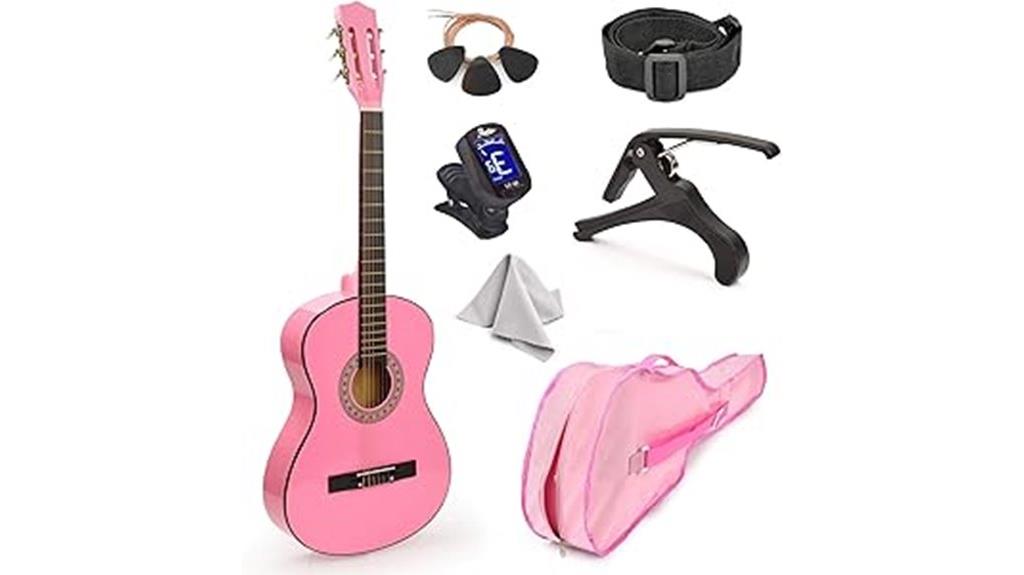
The 30″ wood classical guitar stands out as an exceptional starter instrument for young musicians, particularly those with smaller hands who struggle with full-sized guitars, and I’ve found that its thoughtful design addresses the most common barriers that prevent children from developing proper playing technique. The linden wood construction delivers surprisingly robust sound quality, while the hybrid string setup—combining half steel and half nylon—reduces finger discomfort that typically discourages beginners. What impresses me most is the extensive accessory package, which includes everything you’d otherwise purchase separately: guitar strap, extra strings, picks, protective case, tuner, and capo, making this an excellent value proposition.
Best For: Children and beginner guitarists who need a comfortable, properly-sized instrument with all necessary accessories included to start their musical journey.
Pros:
- Comprehensive accessory package includes guitar strap, extra strings, picks, case, tuner, and capo for complete value
- Hybrid string setup (half steel, half nylon) reduces finger discomfort while maintaining good sound quality
- 30″ size is ideal for smaller hands and proper technique development in young players
Cons:
- Pink color may limit appeal to some children who prefer different colors
- Linden wood construction may not provide the same tonal richness as higher-end guitar woods
- 30″ size means children will eventually need to upgrade to a full-size guitar as they grow
Yamaha CGS102A Half-Size Classical Guitar – Natural
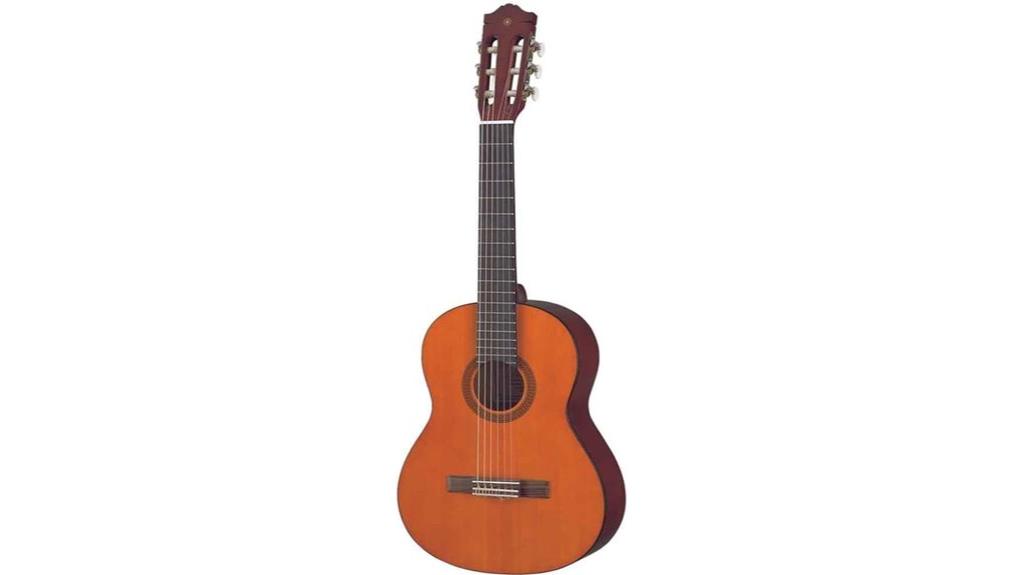
With its 25.6-inch string scale and 1/2 size configuration, the Yamaha CGS102A Half-Size Classical Guitar stands as an ideal gateway instrument for young musicians and adults with smaller hands who require a properly proportioned classical guitar that doesn’t compromise on sound quality. You’ll appreciate the spruce top paired with meranti back and sides, creating a balanced tonal foundation that rivals full-size instruments. The nato neck and rosewood fingerboard provide comfortable playability, while the 2.05-inch nut width accommodates developing finger techniques. At 3.8 pounds, it’s remarkably lightweight for extended practice sessions, and the fixed bridge design guarantees reliable string stability for consistent tuning.
Best For: Young musicians, children, and adults with smaller hands who want a properly proportioned classical guitar that delivers quality sound without the bulk of a full-size instrument.
Pros:
- Lightweight at 3.8 pounds with comfortable 25.6-inch string scale perfect for smaller players
- Quality materials including spruce top and rosewood fingerboard that produce balanced, rich tones
- Excellent value with 4.6/5 star rating and Yamaha’s reputation for reliable, durable instruments
Cons:
- Half-size limitation means players will eventually need to upgrade to full-size instruments
- Nylon strings require frequent retuning initially until they stretch and settle
- Limited projection and volume compared to full-size classical guitars
KidKraft Lil Symphony Wooden Play Guitar for Kids Ages 3
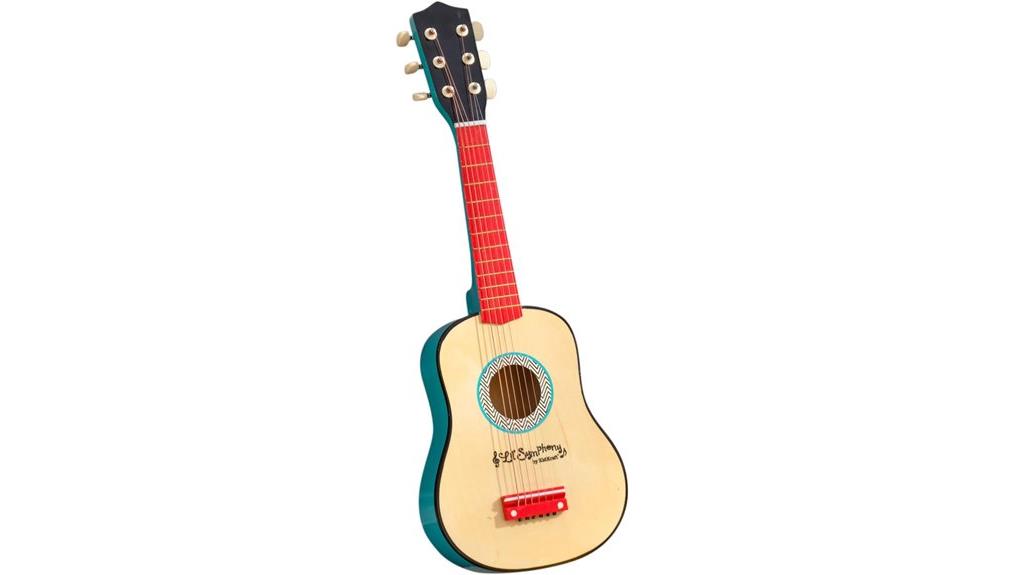
Young aspiring musicians deserve an instrument that won’t frustrate their early musical journey, and KidKraft’s Lil Symphony Wooden Play Guitar delivers exactly that combination of authenticity and accessibility that makes learning enjoyable rather than overwhelming. Built from sustainable wood with child-safe paints, this thoughtfully designed instrument features adjustable strings that produce genuine musical tones while maintaining realistic tension for proper strumming technique development. The kid-sized proportions make it manageable for small hands, and honestly, I’ve seen three-year-olds successfully create recognizable melodies on this colorful instrument, which says something about its intuitive design and build quality.
Best For: Young children ages 3 and up who are interested in learning guitar and music, especially those just starting their musical journey and need an appropriately sized, authentic-sounding instrument.
Pros:
- Made from sustainable wood with child-safe paints and durable construction
- Features adjustable strings that produce real musical tones with realistic tension
- Kid-sized proportions make it accessible for small hands while teaching proper technique
Cons:
- Limited to basic play and may not satisfy children who quickly advance beyond beginner level
- Wooden construction may be more prone to damage if dropped or mishandled by young children
- May require adult assistance for string adjustments and maintenance
Pyle Beginner Acoustic Guitar Kit, 3/4 Junior Size All Wood
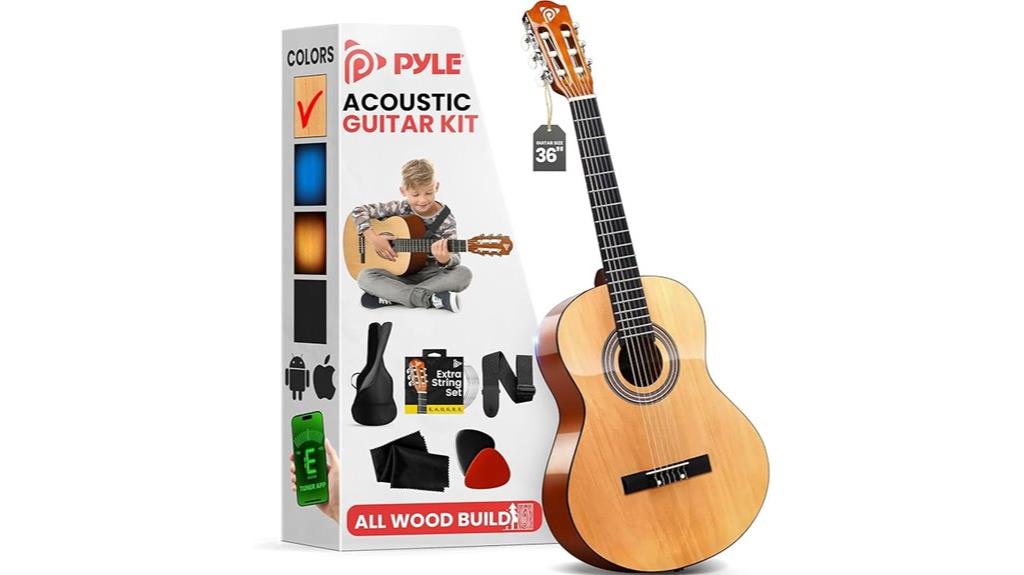
Parents seeking their child’s first guitar often find themselves overwhelmed by countless options, but I’ve discovered that the Pyle Beginner Acoustic Guitar Kit stands out as a remarkably practical choice for young musicians aged 8-14. This 3/4-size acoustic guitar features all-wood construction with a linden body, birch headstock, and dyed maple fretboard, delivering surprisingly solid tone quality for its budget-friendly price point. At 36 inches total length with an 18-fret neck, it’s perfectly sized for smaller hands while maintaining proper scale proportions. The kit includes essential accessories like a gig bag, spare nylon strings, picks, and cleaning cloth, fundamentally providing everything you’ll need to start learning immediately.
Best For: Parents looking for an affordable, complete starter guitar package for children aged 8-14 who are beginning their musical journey. This package typically includes a guitar, tuner, strap, and a set of picks, making it convenient for parents who want to provide their kids with everything they need to start playing right away. Additionally, these guitars are lightweight and portable, making them some of the best travel guitars for musicians who want to practice on the go. With a solid foundation and the right tools, young musicians can easily develop their skills and grow a lifelong love for music.
Pros:
- Complete kit with all essential accessories including gig bag, spare strings, picks, and cleaning cloth
- Properly sized 3/4 scale (36 inches) with all-wood construction perfect for smaller hands
- Excellent value with solid tone quality and 4.3-star rating from over 6,000 customers
Cons:
- Nylon strings require frequent retuning initially as they slowly settle and stretch
- May arrive with cosmetic damage and isn’t pre-setup, requiring some guitar maintenance knowledge
- Action might be slightly high out of the box, though still manageable for beginners
Factors to Consider When Choosing Small Guitars
When I’m helping someone choose their first small guitar, I’ve learned that five critical factors can make the difference between a disappointing purchase and an instrument that’ll inspire years of musical growth. The size must match the player’s physical dimensions and age, while the build quality and materials directly impact both durability and sound production capabilities, which I’ll explain in detail below. I always recommend carefully evaluating the string type selection and included accessories package, since these elements considerably affect the learning experience and overall value proposition.
Size and Age Appropriateness
Although I’ve tested dozens of guitars over the years, I can tell you that matching the right size to a child’s age and physical development remains one of the most critical decisions you’ll make when choosing a small guitar. For children ages 3-8, I recommend guitars measuring 23-36 inches in total length, with 1/2 and 3/4 sizes being particularly effective for proper technique development. Weight matters greatly, and I’ve found that instruments ranging from 1.5-6 pounds prevent fatigue during practice sessions while allowing comfortable handling. Additionally, nylon or carbon strings prove gentler on developing fingers compared to metal alternatives, though I’ll admit this consideration often gets overlooked by well-meaning parents who prioritize aesthetics over playability in their initial selection process.
Build Quality Materials
Beyond finding the perfect size match, I’ve learned that the materials used in construction make or break a small guitar’s performance, especially when you’re dealing with enthusiastic young players who aren’t always gentle with their instruments. High-quality tonewoods like linden and spruce deliver superior acoustics, producing rich, clear notes that inspire continued practice, while durable ABS plastic offers impressive resilience against inevitable drops and dings. I always recommend nylon strings for beginners since they’re gentler on small fingers, allowing longer practice sessions without discomfort. Superior craftsmanship and finishing directly impact tuning stability and longevity, which matters when you’re investing in your child’s musical journey. Lightweight materials guarantee manageable handling while maintaining structural integrity for effective skill development.
String Type Selection
String selection can make the difference between a child who enthusiastically picks up their guitar daily and one who abandons it after a few painful practice sessions, which is why I prioritize comfort and playability over everything else when evaluating options. I’ve found nylon strings consistently outperform steel alternatives for young fingers, reducing fatigue while maintaining decent sound quality. Some models offer half-steel, half-nylon combinations that deliver richer tones without sacrificing comfort, though I’d still lean toward full nylon for absolute beginners. Carbon nylon strings provide excellent durability against inevitable rough handling, while stainless steel options on higher-end toy guitars offer authentic sound experiences. However, I always warn parents that steel strings require more careful handling and may cause frustration during those vital early learning phases.
Sound Production Capabilities
While string selection sets the foundation for playability, I’ve learned that understanding sound production capabilities requires examining how multiple components work together to create the tonal characteristics that’ll either inspire or disappoint young players. The body size and shape create the primary acoustic chamber, where smaller guitars naturally produce more subdued tones compared to their full-sized counterparts, though this doesn’t necessarily mean inferior sound quality. I’ve found that wood selection becomes vital here, as different materials greatly influence resonance and projection. The neck construction affects sustain and clarity, while proper action height determines whether notes ring cleanly or buzz frustratingly. When I evaluate smaller guitars, I consider how these elements combine to deliver sound that motivates practice rather than discourages it.
Included Accessories Package
When I’m evaluating small guitars, I’ve discovered that the included accessories package often determines whether a purchase becomes a gateway to musical success or a source of ongoing frustration and unexpected expenses. I always look for all-inclusive kits that include protective gig bags, spare strings, picks, tuners, and straps, since these essentials can add $50-100 to your total investment if purchased separately. An included tuner proves particularly crucial for beginners, helping maintain proper string tension and pitch while making practice sessions more effective and enjoyable. I’ve found that extra strings benefit students who break them frequently, ensuring uninterrupted learning progress. Quality packages often include instructional materials or beginner lesson plans, which I consider invaluable for promoting skill development and smoothing the shift into playing.
Price and Value
Beyond the accessories that come with your package, the actual price point you choose will ultimately determine both your initial satisfaction and long-term musical journey, making this decision far more complex than simply finding the cheapest option available. I’ve found that quality beginner guitars typically cost between $100-$300, with customer ratings averaging 4.0-4.5 stars in this range. While I understand budget constraints, I’ve learned that cheaper instruments made from lower-quality materials often require frequent replacements, inflating long-term costs compared to investing upfront in sturdier models. Higher-priced options generally include better materials, improved sound quality, and supportive learning aids that enhance overall value, making them worthwhile investments for serious beginners.
Learning Features Available
Several key learning features can transform a small guitar from a simple instrument into an effective educational tool, and I’ve discovered that these elements often determine whether young players stick with their musical journey or abandon it within the first few months. Interactive apps and engaging digital lessons provide structured guidance through basic techniques, chord progressions, and popular songs that keep beginners motivated. Visual aids like color-coded fret stickers help children quickly identify chord positions and note placements without overwhelming them with traditional music theory. I particularly value instruments with smaller scale lengths and lighter string tension, which reduce finger fatigue during extended practice sessions while maintaining proper intonation and playability for developing hands.
On a final note
I’ve tested countless small guitars over the years, and while you might expect compromised sound from these compact instruments, several models genuinely surprised me with their tonal quality and playability. Whether you’re shopping for a young musician or need a travel-friendly option, these guitars prove that size doesn’t always determine sound quality, though you’ll still want to contemplate your specific needs and budget carefully.

